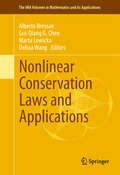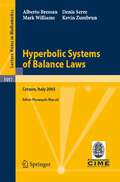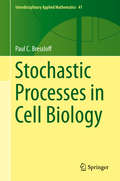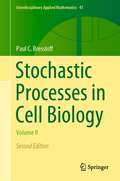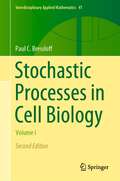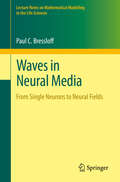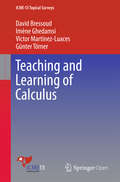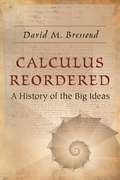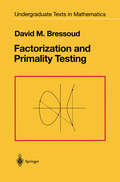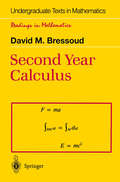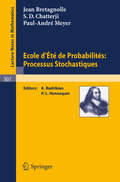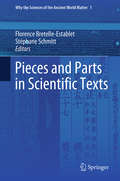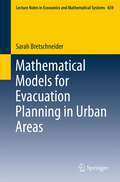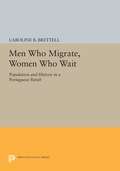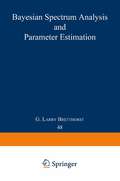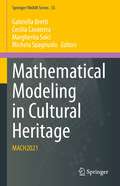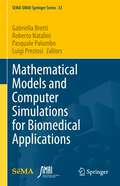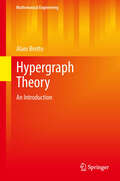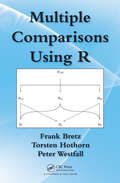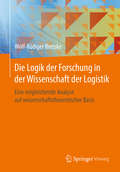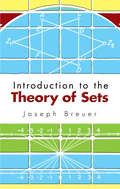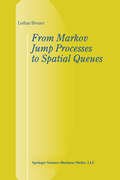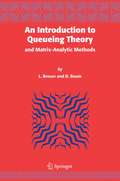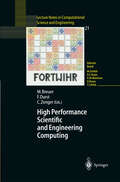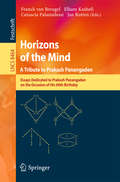- Table View
- List View
Nonlinear Conservation Laws and Applications (The IMA Volumes in Mathematics and its Applications #153)
by Alberto Bressan Marta Lewicka Dehua Wang Gui-Qiang G. ChenThis volume contains the proceedings of the Summer Program on Nonlinear Conservation Laws and Applications held at the IMA on July 13--31, 2009. Hyperbolic conservation laws is a classical subject, which has experienced vigorous growth in recent years. The present collection provides a timely survey of the state of the art in this exciting field, and a comprehensive outlook on open problems. Contributions of more theoretical nature cover the following topics: global existence and uniqueness theory of one-dimensional systems, multidimensional conservation laws in several space variables and approximations of their solutions, mathematical analysis of fluid motion, stability and dynamics of viscous shock waves, singular limits for viscous systems, basic principles in the modeling of turbulent mixing, transonic flows past an obstacle and a fluid dynamic approach for isometric embedding in geometry, models of nonlinear elasticity, the Monge problem, and transport equations with rough coefficients. In addition, there are a number of papers devoted to applications. These include: models of blood flow, self-gravitating compressible fluids, granular flow, charge transport in fluids, and the modeling and control of traffic flow on networks.
Hyperbolic Systems of Balance Laws: Lectures given at the C.I.M.E. Summer School held in Cetraro, Italy, July 14-21, 2003 (Lecture Notes in Mathematics #1911)
by Alberto Bressan Denis Serre Mark Williams Kevin ZumbrunThis volume includes four lecture courses by Bressan, Serre, Zumbrun and Williams and a Tutorial by Bressan on the Center Manifold Theorem. Bressan introduces the vanishing viscosity approach and clearly explains the building blocks of the theory. Serre focuses on existence and stability for discrete shock profiles. The lectures by Williams and Zumbrun deal with the stability of multidimensional fronts.
Stochastic Processes in Cell Biology (Interdisciplinary Applied Mathematics #41)
by Paul C. BressloffThis book develops the theory of continuous and discrete stochastic processes within the context of cell biology. A wide range of biological topics are covered including normal and anomalous diffusion in complex cellular environments, stochastic ion channels and excitable systems, stochastic calcium signaling, molecular motors, intracellular transport, signal transduction, bacterial chemotaxis, robustness in gene networks, genetic switches and oscillators, cell polarization, polymerization, cellular length control, and branching processes. The book also provides a pedagogical introduction to the theory of stochastic process – Fokker Planck equations, stochastic differential equations, master equations and jump Markov processes, diffusion approximations and the system size expansion, first passage time problems, stochastic hybrid systems, reaction-diffusion equations, exclusion processes, WKB methods, martingales and branching processes, stochastic calculus, and numerical methods. This text is primarily aimed at graduate students and researchers working in mathematical biology and applied mathematicians interested in stochastic modeling. Applied probabilists and theoretical physicists should also find it of interest. It assumes no prior background in statistical physics and introduces concepts in stochastic processes via motivating biological applications. The book is highly illustrated and contains a large number of examples and exercises that further develop the models and ideas in the body of the text. It is based on a course that the author has taught at the University of Utah for many years.
Stochastic Processes in Cell Biology: Volume II (Interdisciplinary Applied Mathematics #41)
by Paul C. BressloffThis book develops the theory of continuous and discrete stochastic processes within the context of cell biology. In the second edition the material has been significantly expanded, particularly within the context of nonequilibrium and self-organizing systems. Given the amount of additional material, the book has been divided into two volumes, with volume I mainly covering molecular processes and volume II focusing on cellular processes. A wide range of biological topics are covered in the new edition, including stochastic ion channels and excitable systems, molecular motors, stochastic gene networks, genetic switches and oscillators, epigenetics, normal and anomalous diffusion in complex cellular environments, stochastically-gated diffusion, active intracellular transport, signal transduction, cell sensing, bacterial chemotaxis, intracellular pattern formation, cell polarization, cell mechanics, biological polymers and membranes, nuclear structure and dynamics, biological condensates, molecular aggregation and nucleation, cellular length control, cell mitosis, cell motility, cell adhesion, cytoneme-based morphogenesis, bacterial growth, and quorum sensing. The book also provides a pedagogical introduction to the theory of stochastic and nonequilibrium processes – Fokker Planck equations, stochastic differential equations, stochastic calculus, master equations and jump Markov processes, birth-death processes, Poisson processes, first passage time problems, stochastic hybrid systems, queuing and renewal theory, narrow capture and escape, extreme statistics, search processes and stochastic resetting, exclusion processes, WKB methods, large deviation theory, path integrals, martingales and branching processes, numerical methods, linear response theory, phase separation, fluctuation-dissipation theorems, age-structured models, and statistical field theory. This text is primarily aimed at graduate students and researchers working in mathematical biology, statistical and biological physicists, and applied mathematicians interested in stochastic modeling. Applied probabilists should also find it of interest. It provides significant background material in applied mathematics and statistical physics, and introduces concepts in stochastic and nonequilibrium processes via motivating biological applications. The book is highly illustrated and contains a large number of examples and exercises that further develop the models and ideas in the body of the text. It is based on a course that the author has taught at the University of Utah for many years.
Stochastic Processes in Cell Biology: Volume I (Interdisciplinary Applied Mathematics #41)
by Paul C. BressloffThis book develops the theory of continuous and discrete stochastic processes within the context of cell biology. In the second edition the material has been significantly expanded, particularly within the context of nonequilibrium and self-organizing systems. Given the amount of additional material, the book has been divided into two volumes, with volume I mainly covering molecular processes and volume II focusing on cellular processes. A wide range of biological topics are covered in the new edition, including stochastic ion channels and excitable systems, molecular motors, stochastic gene networks, genetic switches and oscillators, epigenetics, normal and anomalous diffusion in complex cellular environments, stochastically-gated diffusion, active intracellular transport, signal transduction, cell sensing, bacterial chemotaxis, intracellular pattern formation, cell polarization, cell mechanics, biological polymers and membranes, nuclear structure and dynamics, biological condensates, molecular aggregation and nucleation, cellular length control, cell mitosis, cell motility, cell adhesion, cytoneme-based morphogenesis, bacterial growth, and quorum sensing. The book also provides a pedagogical introduction to the theory of stochastic and nonequilibrium processes – Fokker Planck equations, stochastic differential equations, stochastic calculus, master equations and jump Markov processes, birth-death processes, Poisson processes, first passage time problems, stochastic hybrid systems, queuing and renewal theory, narrow capture and escape, extreme statistics, search processes and stochastic resetting, exclusion processes, WKB methods, large deviation theory, path integrals, martingales and branching processes, numerical methods, linear response theory, phase separation, fluctuation-dissipation theorems, age-structured models, and statistical field theory. This text is primarily aimed at graduate students and researchers working in mathematical biology, statistical and biological physicists, and applied mathematicians interested in stochastic modeling. Applied probabilists should also find it of interest. It provides significant background material in applied mathematics and statistical physics, and introduces concepts in stochastic and nonequilibrium processes via motivating biological applications. The book is highly illustrated and contains a large number of examples and exercises that further develop the models and ideas in the body of the text. It is based on a course that the author has taught at the University of Utah for many years.
Waves in Neural Media: From Single Neurons to Neural Fields (Lecture Notes on Mathematical Modelling in the Life Sciences)
by Paul C. BressloffWaves in Neural Media: From Single Neurons to Neural Fields surveys mathematical models of traveling waves in the brain, ranging from intracellular waves in single neurons to waves of activity in large-scale brain networks. The work provides a pedagogical account of analytical methods for finding traveling wave solutions of the variety of nonlinear differential equations that arise in such models. These include regular and singular perturbation methods, weakly nonlinear analysis, Evans functions and wave stability, homogenization theory and averaging, and stochastic processes. Also covered in the text are exact methods of solution where applicable. Historically speaking, the propagation of action potentials has inspired new mathematics, particularly with regard to the PDE theory of waves in excitable media. More recently, continuum neural field models of large-scale brain networks have generated a new set of interesting mathematical questions with regard to the solution of nonlocal integro-differential equations. Advanced graduates, postdoctoral researchers and faculty working in mathematical biology, theoretical neuroscience, or applied nonlinear dynamics will find this book to be a valuable resource. The main prerequisites are an introductory graduate course on ordinary differential equations or partial differential equations, making this an accessible and unique contribution to the field of mathematical biology.
Teaching and Learning of Calculus (ICME-13 Topical Surveys)
by David Bressoud Imène Ghedamsi Victor Martinez-Luaces Günter TörnerThis survey focuses on the main trends in the field of calculus education. Despite their variety, the findings reveal a cornerstone issue that is strongly linked to the formalism of calculus concepts and to the difficulties it generates in the learning and teaching process. As a complement to the main text, an extended bibliography with some of the most important references on this topic is included. Since the diversity of the research in the field makes it difficult to produce an exhaustive state-of-the-art summary, the authors discuss recent developments that go beyond this survey and put forward new research questions.
Calculus Reordered: A History of the Big Ideas
by David M. BressoudHow our understanding of calculus has evolved over more than three centuries, how this has shaped the way it is taught in the classroom, and why calculus pedagogy needs to changeCalculus Reordered takes readers on a remarkable journey through hundreds of years to tell the story of how calculus evolved into the subject we know today. David Bressoud explains why calculus is credited to seventeenth-century figures Isaac Newton and Gottfried Leibniz, and how its current structure is based on developments that arose in the nineteenth century. Bressoud argues that a pedagogy informed by the historical development of calculus represents a sounder way for students to learn this fascinating area of mathematics.Delving into calculus’s birth in the Hellenistic Eastern Mediterranean—particularly in Syracuse, Sicily and Alexandria, Egypt—as well as India and the Islamic Middle East, Bressoud considers how calculus developed in response to essential questions emerging from engineering and astronomy. He looks at how Newton and Leibniz built their work on a flurry of activity that occurred throughout Europe, and how Italian philosophers such as Galileo Galilei played a particularly important role. In describing calculus’s evolution, Bressoud reveals problems with the standard ordering of its curriculum: limits, differentiation, integration, and series. He contends that the historical order—integration as accumulation, then differentiation as ratios of change, series as sequences of partial sums, and finally limits as they arise from the algebra of inequalities—makes more sense in the classroom environment.Exploring the motivations behind calculus’s discovery, Calculus Reordered highlights how this essential tool of mathematics came to be.
Factorization and Primality Testing (Undergraduate Texts in Mathematics)
by David M. Bressoud"About binomial theorems I'm teeming with a lot of news, With many cheerful facts about the square on the hypotenuse. " - William S. Gilbert (The Pirates of Penzance, Act I) The question of divisibility is arguably the oldest problem in mathematics. Ancient peoples observed the cycles of nature: the day, the lunar month, and the year, and assumed that each divided evenly into the next. Civilizations as separate as the Egyptians of ten thousand years ago and the Central American Mayans adopted a month of thirty days and a year of twelve months. Even when the inaccuracy of a 360-day year became apparent, they preferred to retain it and add five intercalary days. The number 360 retains its psychological appeal today because it is divisible by many small integers. The technical term for such a number reflects this appeal. It is called a "smooth" number. At the other extreme are those integers with no smaller divisors other than 1, integers which might be called the indivisibles. The mystic qualities of numbers such as 7 and 13 derive in no small part from the fact that they are indivisibles. The ancient Greeks realized that every integer could be written uniquely as a product of indivisibles larger than 1, what we appropriately call prime numbers. To know the decomposition of an integer into a product of primes is to have a complete description of all of its divisors.
Second Year Calculus: From Celestial Mechanics to Special Relativity (Undergraduate Texts in Mathematics)
by David M. BressoudSecond Year Calculus: From Celestial Mechanics to Special Relativity covers multi-variable and vector calculus, emphasizing the historical physical problems which gave rise to the concepts of calculus. The book guides us from the birth of the mechanized view of the world in Isaac Newton's Mathematical Principles of Natural Philosophy in which mathematics becomes the ultimate tool for modelling physical reality, to the dawn of a radically new and often counter-intuitive age in Albert Einstein's Special Theory of Relativity in which it is the mathematical model which suggests new aspects of that reality. The development of this process is discussed from the modern viewpoint of differential forms. Using this concept, the student learns to compute orbits and rocket trajectories, model flows and force fields, and derive the laws of electricity and magnetism. These exercises and observations of mathematical symmetry enable the student to better understand the interaction of physics and mathematics.
Ecole d'Ete de Probabilites: Processus Stochastiques (Lecture Notes in Mathematics #307)
by J. L. Bretagnolle S. D. Chatterji P.-A. MeyerPieces and Parts in Scientific Texts (Why the Sciences of the Ancient World Matter #1)
by Florence Bretelle-Establet Stéphane SchmittThis book starts from a first general observation: there are very diverse ways to frame and convey scientific knowledge in texts. It then analyzes texts on mathematics, astronomy, medicine and life sciences, produced in various parts of the globe and in different time periods, and examines the reasons behind the segmentation of texts and the consequences of such textual divisions. How can historians and philosophers of science approach this diversity, and what is at stake in dealing with it? The book addresses these questions, adopting a specific approach to do so. In order to shed light on the diversity of organizational patterns and rhetorical strategies in scientific texts, and to question the rationale behind the choices made to present such texts in one particular way, it focuses on the issue of text segmentation, offering answers to questions such as: What was the meaning of segmenting texts into paragraphs, chapters, sections and clusters? Was segmentation used to delimit self-contained units, or to mark breaks in the physical appearance of a text in order to aid reading and memorizing, or to cope with the constraints of the material supports? How, in these different settings and in different texts, were pieces and parts made visible?
Mathematical Models for Evacuation Planning in Urban Areas (Lecture Notes in Economics and Mathematical Systems #659)
by Sarah BretschneiderDisasters like floods, hurricanes, chemical or nuclear accidents may cause the necessity to evacuate the affected area. The evacuation of the urban area needs to be planned carefully. One issue is the reorganization of the traffic routing. Congested urban areas have usually complex street networks that are composed of many intersections with streets connecting them. The population density of a congested urban area is usually high and the street network is already used to capacity during rush hour traffic. The considered problem of this work is the reorganization of the traffic routing of an urban area for the case of an emergency mass evacuation. Especially aspects of the evacuation like safety, avoidance of delays and the total system travel time are taken into account. Combinatorial and graph theoretical aspects are adapted for the evacuation problem and highlight issues concerning especially conflicts within intersections. This work gives an extensive summary of literature of evacuation of urban areas. Mixed-integer linear programming models are developed for evacuation problems and heuristic algorithms are provided and tested.?
Men Who Migrate, Women Who Wait: Population and History in a Portuguese Parish
by Caroline B. BrettellThe author examines not only the imbalance in the marital fortunes of men and women but its effect on the roles of women in the community.Originally published in 1987.The Princeton Legacy Library uses the latest print-on-demand technology to again make available previously out-of-print books from the distinguished backlist of Princeton University Press. These editions preserve the original texts of these important books while presenting them in durable paperback and hardcover editions. The goal of the Princeton Legacy Library is to vastly increase access to the rich scholarly heritage found in the thousands of books published by Princeton University Press since its founding in 1905.
Bayesian Spectrum Analysis and Parameter Estimation (Lecture Notes in Statistics #48)
by G. Larry BretthorstThis work is essentially an extensive revision of my Ph.D. dissertation, [1J. It 1S primarily a research document on the application of probability theory to the parameter estimation problem. The people who will be interested in this material are physicists, economists, and engineers who have to deal with data on a daily basis; consequently, we have included a great deal of introductory and tutorial material. Any person with the equivalent of the mathematics background required for the graduate level study of physics should be able to follow the material contained in this book, though not without eIfort. From the time the dissertation was written until now (approximately one year) our understanding of the parameter estimation problem has changed extensively. We have tried to incorporate what we have learned into this book. I am indebted to a number of people who have aided me in preparing this docu ment: Dr. C. Ray Smith, Steve Finney, Juana Sunchez, Matthew Self, and Dr. Pat Gibbons who acted as readers and editors. In addition, I must extend my deepest thanks to Dr. Joseph Ackerman for his support during the time this manuscript was being prepared.
Mathematical Modeling in Cultural Heritage: MACH2021 (Springer INdAM Series #55)
by Gabriella Bretti Cecilia Cavaterra Margherita Solci Michela SpagnuoloThis book collects contributions presented at the INdAM Workshop "Mathematical modeling and Analysis of degradation and restoration in Cultural Heritage–MACH2021", held in Rome, Italy in September 2021. The book is focused on mathematical modeling and simulation techniques with the aim of improving the current strategies of conservation and restoration in cultural heritage, sharing different experiences and approaches.The main topics are corrosion and sulphation of materials, damage and fractures, stress in thermomechanical systems, contact and adhesion problems, and phase transitions.
Mathematical Models and Computer Simulations for Biomedical Applications (SEMA SIMAI Springer Series #33)
by Gabriella Bretti Roberto Natalini Pasquale Palumbo Luigi PreziosiMathematical modelling and computer simulations are playing a crucial role in the solution of the complex problems arising in the field of biomedical sciences and provide a support to clinical and experimental practices in an interdisciplinary framework.Indeed, the development of mathematical models and efficient numerical simulation tools is of key importance when dealing with such applications.Moreover, since the parameters in biomedical models have peculiar scientific interpretations and their values are often unknown, accurate estimation techniques need to be developed for parameter identification against the measured data of observed phenomena. In the light of the new challenges brought by the biomedical applications, computational mathematics paves the way for the validation of the mathematical models and the investigation of control problems.The volume hosts high-quality selected contributions containing original research results as well as comprehensive papers and survey articles including prospective discussion focusing on some topical biomedical problems. It is addressed, but not limited to: research institutes, academia, and pharmaceutical industries.
Hypergraph Theory: An Introduction (Mathematical Engineering)
by Alain BrettoThis book provides an introduction to hypergraphs, its aim being to overcome the lack of recent manuscripts on this theory. In the literature hypergraphs have many other names such as set systems and families of sets. This work presents the theory of hypergraphs in its most original aspects, while also introducing and assessing the latest concepts on hypergraphs. The variety of topics, their originality and novelty are intended to help readers better understand the hypergraphs in all their diversity in order to perceive their value and power as mathematical tools. This book will be a great asset to upper-level undergraduate and graduate students in computer science and mathematics. It has been the subject of an annual Master's course for many years, making it also ideally suited to Master's students in computer science, mathematics, bioinformatics, engineering, chemistry, and many other fields. It will also benefit scientists, engineers and anyone else who wants to understand hypergraphs theory.
Multiple Comparisons Using R
by Frank Bretz Torsten Hothorn Peter WestfallAdopting a unifying theme based on maximum statistics, Multiple Comparisons Using R describes the common underlying theory of multiple comparison procedures through numerous examples. It also presents a detailed description of available software implementations in R. The R packages and source code for the analyses are available at http://CRAN.R-pro
Die Logik der Forschung in der Wissenschaft der Logistik: Eine vergleichende Analyse auf wissenschaftstheoretischer Basis
by Wolf-Rüdiger BretzkeZiel dieses Buches ist es, ein Nachdenken (idealerweise eine Diskussion) über ein grundlegendes, methodologisches Problem in der Wissenschaft von der Logistik anzuregen (gelegentlich auch zu provozieren) - ein Problem, über das niemand spricht, obwohl es für die Fortentwicklung dieser Disziplin von grundlegender Bedeutung ist. Dieser Disziplin mangelt es an einer kritischen Reflexion der Erfolgsvoraussetzungen und Grenzen des eigenen Forschens, und das gilt im Grundsatz für alle drei hier beleuchteten Forschungsansätze. Dementsprechend kann eine solche Reflexion auch große Chancen erschließen, für die Wissenschaft und für die Praxis.
Introduction to the Theory of Sets (Dover Books on Mathematics)
by Joseph Breuer Howard F. FehrSet theory permeates much of contemporary mathematical thought. This text for undergraduates offers a natural introduction, developing the subject through observations of the physical world. Its progressive development leads from concrete finite sets to cardinal numbers, infinite cardinals, and ordinals.Although set theory begins in the intuitive and the concrete, it ascends to a very high degree of abstraction. All that is necessary to its grasp, declares author Joseph Breuer, is patience. Breuer illustrates the grounding of finite sets in arithmetic, permutations, and combinations, which provides the terminology and symbolism for further study. Discussions of general theory lead to a study of ordered sets, concluding with a look at the paradoxes of set theory and the nature of formalism and intuitionalism. Answers to exercises incorporated throughout the text appear at the end, along with an appendix featuring glossaries and other helpful information.
From Markov Jump Processes to Spatial Queues
by L. BreuerFrom Markov Jump Processes to Spatial Queues aims to develop a unified theory of spatial queues that yields concrete results for the performance analysis of mobile communication networks. A particular objective is to develop the most natural generalization of existing concepts (e.g. the BMAP) toward the needs of mobile communication networks. To these belong the spatial distribution of batch arrivals and users in the system as well as time-inhomogeneous (e.g. periodic) arrival intensities and user movements. One of the major recent challenges for the stochastic modelling of communication systems is the emergence of wireless networks, which are used by more and more subscribers today. The main new feature of those, which is not covered by classical queuing theory, clearly is the importance of the user location within the area that is served by the base stations of the network. In the framework of queuing theory, this opens up the natural extension of classical queuing models towards queues with a structured space in which users are served. The present book is intended to introduce this extension under the name of spatial queues. The main point of view and the general approach will be that of Markov jump processes. We start with a closer look into the theory. Then we present new results for the theory of stochastic processes as well as for classical queuing theory. Finally we introduce the new concepts of spatial Markovian arrival processes and spatial queues. The main text is divided into three parts. The first part provides a new presentation of the theory of Markov jump processes. We derive a number of new results, especially for time-inhomogeneous processes, which have been neglected too much in the current textbooks on stochastic processes. For the first time, the class of Markov-additive jump processes is analysed in detail. This extends and unifies all Markovian arrival processes that have been proposed up to now (including arrivals for fluid queues) and provides a foundation for the subsequent introduction of spatial Markovian arrival processes. The second part contains new results for classical queues with BMAP input. These include the first explicit formulae for the distribution of periodic queues. The class of fluid Markovian arrival processes is introduced, and we give statistical estimates for the parameters of a BMAP. In the third part, the concepts of spatial Markovian arrival processes (abbreviated: SMAPs) and spatial queues are introduced. After that, periodic spatial Markovian queues are analysed as a model for the cells of a wireless communication network. From Markov Jump Processes to Spatial Queues is intended to reach queuing theorists, researchers in the field of communication systems, as well as engineers with some background in probability theory. Furthermore, it is suitable as a textbook for advanced queuing theory on the graduate or post-graduate level.
An Introduction to Queueing Theory: and Matrix-Analytic Methods
by L. Breuer Dieter BaumThe present textbook contains the recordsof a two–semester course on que- ing theory, including an introduction to matrix–analytic methods. This course comprises four hours oflectures and two hours of exercises per week andhas been taughtattheUniversity of Trier, Germany, for about ten years in - quence. The course is directed to last year undergraduate and?rst year gr- uate students of applied probability and computer science, who have already completed an introduction to probability theory. Its purpose is to present - terial that is close enough to concrete queueing models and their applications, while providing a sound mathematical foundation for the analysis of these. Thus the goal of the present book is two–fold. On the one hand, students who are mainly interested in applications easily feel bored by elaborate mathematical questions in the theory of stochastic processes. The presentation of the mathematical foundations in our courses is chosen to cover only the necessary results, which are needed for a solid foundation of the methods of queueing analysis. Further, students oriented - wards applications expect to have a justi?cation for their mathematical efforts in terms of immediate use in queueing analysis. This is the main reason why we have decided to introduce new mathematical concepts only when they will be used in the immediate sequel. On the other hand, students of applied probability do not want any heur- tic derivations just for the sake of yielding fast results for the model at hand.
High Performance Scientific And Engineering Computing: Proceedings of the 3rd International FORTWIHR Conference on HPSEC, Erlangen, March 12–14, 2001 (Lecture Notes in Computational Science and Engineering #21)
by Michael Breuer Franz Durst Christoph ZengerIn Douglas Adams' book 'Hitchhiker's Guide to the Galaxy', hyper-intelligent beings reached a point in their existence where they wanted to understand the purpose of their own existence and the universe. They built a supercomputer, called Deep Thought, and upon completion, they asked it for the answer to the ultimate question of life, the universe and everything else. The computer worked for several millennia on the answers to all these questions. When the day arrived for hyper-intelligent beings the to receive the answer, they were stunned, shocked and disappointed to hear that the answer was simply 42. The still open questions to scientists and engineers are typically much sim pler and consequently the answers are more reasonable. Furthermore, because human beings are too impatient and not ready to wait for such a long pe riod, high-performance computing techniques have been developed, leading to much faster answers. Based on these developments in the last two decades, scientific and engineering computing has evolved to a key technology which plays an important role in determining, or at least shaping, future research and development activities in many branches of industry. Development work has been going on all over the world resulting in numerical methods that are now available for simulations that were not foreseeable some years ago. However, these days the availability of supercomputers with Teraflop perfor mance supports extensive computations with technical relevance. A new age of engineering has started.
Horizons of the Mind. A Tribute to Prakash Panangaden: Essays Dedicated to Prakash Panangaden on the Occasion of His 60th Birthday (Lecture Notes in Computer Science #8464)
by Franck Van Breugel Elham Kashefi Catuscia Palamidessi Jan RuttenThis Festschrift volume contains papers presented at a conference, Prakash Fest, held in honor of Prakash Panangaden, in Oxford, UK, in May 2014, to celebrate his 60th birthday. Prakash Panangaden has worked on a large variety of topics including probabilistic and concurrent computation, logics and duality and quantum information and computation. Despite the enormous breadth of his research, he has made significant and deep contributions. For example, he introduced logic and a real-valued interpretation of the logic to capture equivalence of probabilistic processes quantitatively. The 25 papers included in this volume were carefully reviewed. They cover a large variety of topics in theoretical computer science.
